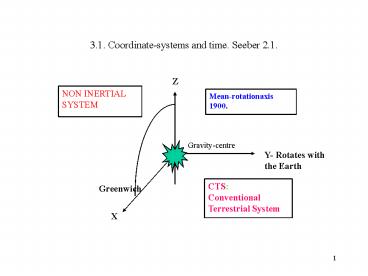3'1' Coordinatesystems and time' Seeber 2'1' - PowerPoint PPT Presentation
1 / 27
Title:
3'1' Coordinatesystems and time' Seeber 2'1'
Description:
Zero-meridian for Bureau Internationale de l' Heure (BHI) determined so that ... Polbev gelse, 1994-1997, Fuld linie : middel pol bev gelse, 1900-1996. 7. Kap. ... – PowerPoint PPT presentation
Number of Views:66
Avg rating:3.0/5.0
Title: 3'1' Coordinatesystems and time' Seeber 2'1'
1
3.1. Coordinate-systems and time. Seeber 2.1.
Z
NON INERTIAL SYSTEM
Mean-rotationaxis 1900.
Gravity-centre
Y- Rotates with the Earth
CTS Conventional Terrestrial System
Greenwich
X
2
CIS
- Zero-meridian for Bureau Internationale de l
Heure (BHI) determined so that star-catalogues
agree in the mean with observations from
astronomical observatories. - The connection to an Inertial System is
determined using knowledge of the Z-axís (Polar
motion), rotational velocity and the movement of
the Earth Center. - We obtain an Quasi-Inertial system, CIS.
- More correct to use the Sun or the centre of our
galaxe !
3
Kap. 3 POLAR MOTION
- Approximatively circular
- Period 430 days (Chandler period)
- Main reason Axis of Inertia does not co-inside
with axis of rotation. - Rigid Earth 305 days Euler-period.
4
Ch. 3 POLBEVÆGELSEN
- .
5
Kap. 3 POLAR MOVEMENT
- Coordinates for the Polen and Rotational velocity
- IERS (http//www.iers.org)
- International Earth Rotation and Reference System
service (IAG IAU) - http//aiuws.unibe.ch/code/erp_pp.gif
- Metods
- VLBI (Radio astronomi)
- LLR (Laser ranging to the Moon)
- SLR (Satellite Laser ranging)
- GPS, DORIS
6
Kap. 3
- Polbevægelse, 1994-1997, Fuld linie middel pol
bevægelse, 1900-1996
7
Kap. 3. International Terrestrial Reference
System (ITRS)
- Defined, realised and controlled by IERS ITRS
Center. http//www.iers.org/iers/products/itrs/ - Geocentric, mass-centre from total Earth
inclusive oceans and atmosphere. - IERS Reference Pole (IRP) and Reference Meridian
(IRM) konsist with BIH directions within /-
0.005".
8
Kap. 3, ITRS.
- Time-wise change of the orientations secured
through 0-rotation-condition taking into account
horizontal tectonic movements for the whole
Earth. - ITRS realised from estimate of coordinates for
set of station with observations of VLBI, LLR,
GPS, SLR, and DORIS. See ftp//lareg.ensg.ign.fr/
pub/itrf/old/itrf92.ssc
9
Kap. 3
- Paris, 1 July 2003
Bulletin C 26 - INFORMATION ON UTC -
TAI - NO positive leap second will be introduced at
the end of December 2003. - The difference between UTC and the International
Atomic Time TAI is - from 1999 January 1, 0h UTC, until further
notice UTC-TAI -32 s - Leap seconds can be introduced in UTC at the end
of the months of December or June, depending on
the evolution of UT1-TAI. Bulletin C is mailed
every six months, either to announce a time step
in UTC, or to confirm that there will be no time
step at the next possible date. - http//www.iers.org/iers/products/eop/leap_second.
html
10
Kap. 3
11
Kap. 3 Variationer jord-rotationen.
12
Kap. 3
13
Ch. 3, Transformation CIS - CTS
- Precession
- Nutation
- Rotation
- Polar movement
SunMoon
14
Ch. 3, Precession.
- Example t-t00.01 (2001-01-01)
- .
15
Ch. 3, Nutation primarily related to the
Moon.
- Movement takes place in Ecliptica
16
Ch. 3, Nutation
- .
17
Ch. 3, Earth rotation and polar motion (ERP).
- .
18
Ch. 3, Example for point on Equator.
- Suppose ?0, xpyp 1 (30 m)
- .
19
Ch. 3,
Exercise.
- 2 May 1994
- x0.18430.000000893,
- y0.33090.0000014651
- (x,y,z)(3513648.63m,778953.56m,5248202.81m)
- Compute changes to coordinates.
20
Ch. 3, Time requirement
- 1 cm at Equator is 210-5 s in rotation
- 1 cm in satellite movement is 10-6 s
- 1 cm in distance measurement is 310-11 s
- We must measure better than these quantities.
- Not absolute, but time-differences.
21
Ch. 3, Siderial time and UT. (see fig. 2.13).
- Siderial time Hour-angle of vernal equinox in
relationship to the observing instrument - LAST Local apparent siderial time true hour
angle - GAST LAST for Greenwich
- LMST Local hour angle of mean equinox
- GMST LMST for Greenwich
- GMST-GAST??cose
- LMST-GMSTLAST-GAST?
xp
22
Ch. 3, UT
- UT 12 hours Greenwich hourangle for the mean
sun. Follows siderial time. - 1 mean siderial day 1 mean solar day
-3m55.909s. - UT0B is time at observation point B, must be
referred to conventional pole - UT1 UT0B ??P
23
Ch. 3, UT1, GMST and MJD
- .
24
Ch. 3, Dynamic time
- ET Ephemeis time (1952) to make equatins of
motion OK. - TDB Barycentric time refers to the Sun
- TDTTerrestrial time
- From general relativity clock at the earth
moving around the sun varies 0.0016 s due to
change in potential of sun (Earth does not move
with constant velocity). - TDBET on 1984-01-01
25
Ch. 3, GPS Time
- GPS time UTC 1980-01-05
- Determined from Clocks in GPS satellites
- GPS time UTC n s-C0,
- C0 about 300 ns
26
Ch. 3, Clocks and frequency standards.
- With GPS we count cycles. Expect the fequency to
be constant.
27
Ch. 3, Praxis, see Seeber, Fig. 2.15.
- Precision quarts crystal temperature dependent,
aging - Rubidium good stability, long term
- Cesium stable both on short term and long term
transportable, commercially available. - Hydrogen masers 10-15 stability in periods of
102 to 105 s. - Pulsars period e.g. 1.6 ms.































